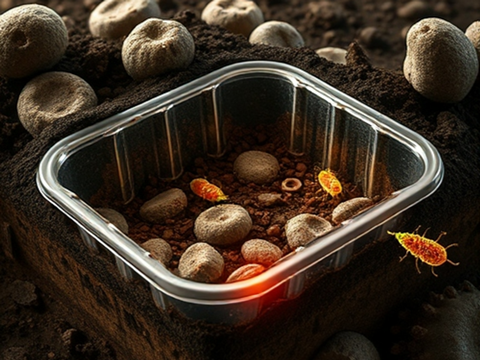
At this year’s Sustainable Packaging Summit in Amsterdam, Gem-Pack Berries announced its partnership with Reborn Material to utilize its enzyme additive technology to create PET clamshell packaging for berries, said to integrate ‘seamlessly’ into the PET manufacturing process.
Gem-Pack Berries says the additive is mixed with PET during production, maintaining the strength, clarity, and functionality required for clamshell packaging. When disposed of in soil or compost, the additive activates under environmental conditions like moisture and microbial activity, breaking the PET into smaller fragments.
Apparently, soil microbes then consume these fragments, converting them into water, carbon dioxide and biomass, leaving no microplastics or harmful residues behind. The packaging naturally integrates into ecosystems, aiming to support sustainability without compromising on recyclability.
Madu Etchandy, SVP of operations at Gem-Pack Berries, commented: “Our partnership with Reborn Material Inc. enables us to take real steps toward reducing our environmental impact while maintaining the quality our customers expect.”
Jason Kang, COO of Reborn Material Inc., added: “Gem-Pack’s dedication to innovation and sustainability makes them an ideal partner in showing how businesses can align with nature through responsible practices.”
In related news, Plastpom announced in February that it had designed a compostable and biodegradable material based on potato starch, in collaboration with the Gdańsk University of Technology and other scientific centres. Seeking to reduce environmental impact and lower CO2 emissions, the material is reportedly free of both artificial ingredients and plastics and is not thought to leave behind microplastics when it decomposes.
Earlier this month, UPM Specialty Papers and Eastman created a pack for food applications requiring grease and oxygen barriers with a compostable, biopolymer coating. Designed for recycling within existing fibre recycling streams, the solution is reportedly compatible with conventional LDPE (low-density polyethylene) extrusion coating equipment.
If you liked this story, you might also enjoy:
The ultimate guide to the Packaging and Packaging Waste Regulation in 2024
How are the top brands progressing on packaging sustainability?
Sustainable Innovation Report 2024: Current trends and future priorities
Everything you need to know about global plastic sustainability regulation












No comments yet